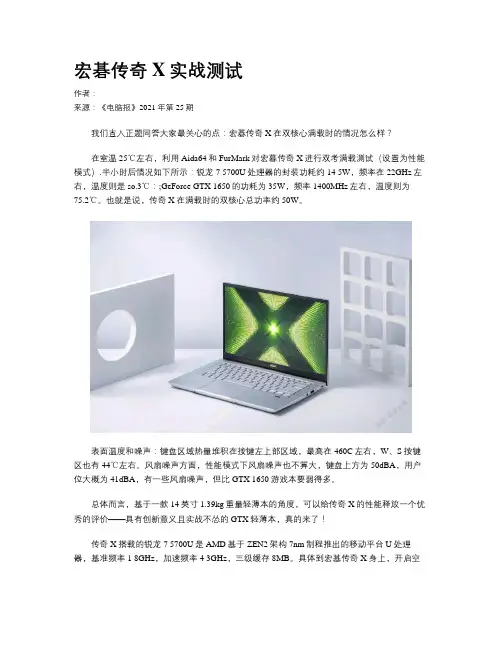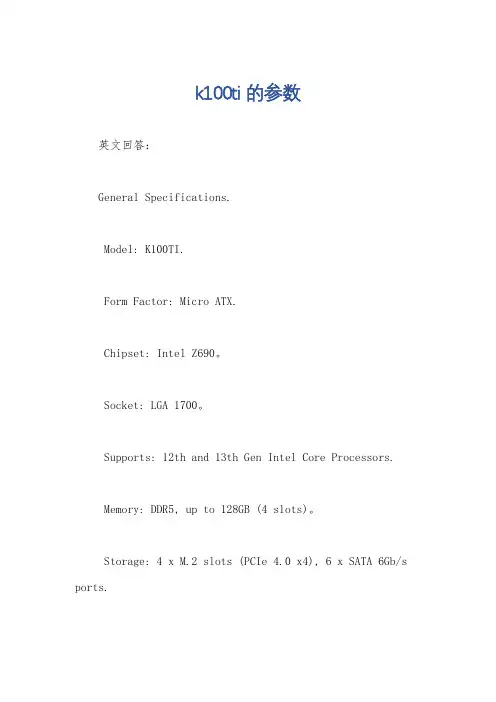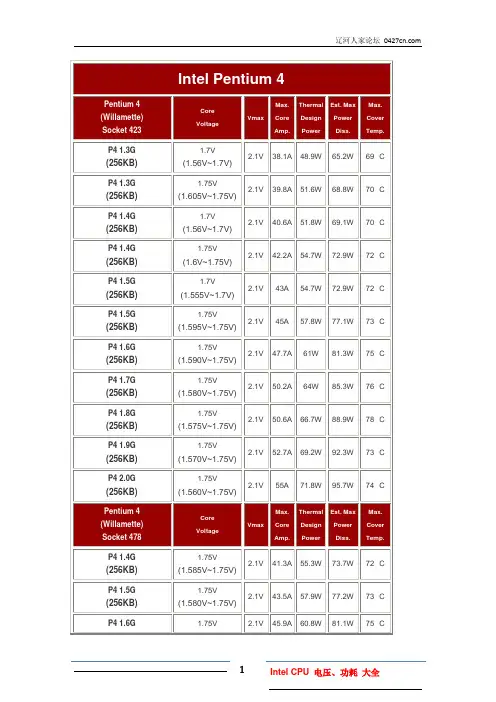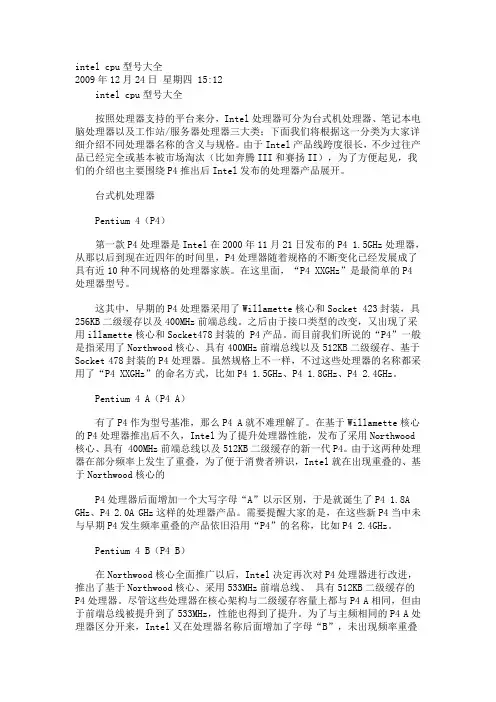Turbocharger-TAD1241 1242GE
宏碁传奇X实战测试

宏碁传奇X实战测试作者:来源:《电脑报》2021年第25期我们直入正题同答大家最关心的点:宏碁传奇X在双核心满载时的情况怎么样?在室温25℃左右,利用Aida64和FurMark对宏暮传奇X进行双考满载测试(设置为性能模式).半小时后情况如下所示:锐龙7 5700U处理器的封装功耗约14 5W,频率在22GHz左右,温度则是so.3℃:;GeForce GTX 1650的功耗为35W,频率1400MHz左右,温度则为75.2℃。
也就是说,传奇X在满载时的双核心总功率约50W。
表面温度和噪声:键盘区域热量堆积在按键左上部区域,最高在460C左右,W、S按键区也有44℃左右。
风扇噪声方面,性能模式下风扇噪声也不算大,键盘上方为50dBA,用户位大概为41dBA,有一些风扇噪声,但比GTX 1650游戏本要弱得多。
总体而言,基于一款14英寸1.39kg重量轻薄本的角度,可以给传奇X的性能释放一个优秀的评价——具有创新意义且实战不怂的GTX轻薄本,真的来了!传奇X搭载的锐龙7 5700U是AMD基于ZEN2架构7nm制程推出的移动平台U处理器,基准频率1 8GHz,加速频率4 3GHz,三级缓存8MB。
具体到宏基传奇X身上,开启空调并设置室温为25℃,该机考机时会稳定在29.5W左右的功率下,频率达到了3GHz以上——无论是功率还是频率,对于一款U处理器轻薄本来说,这样的考机表现都是非常强力的。
基准测试如右表所示,参考对象為稳定70W的l7 10870H。
从测试来看,在爆发性能状态测试中,传奇X的锐龙7 5700U在多个基准测试中超越了稳定70W输出的l7 10870H,比如Cinebench系列基准备试,CPU-Z基准测试等等,都有一定幅度的领先。
在长时间满载测试中,牛叔选择了C4D渲染和Blender六个场景连续渲染来考查宏暮传奇X的持续性能表现。
测试时间比较长的C4D渲染中,传奇X最终用时为30分44秒,效率很不错,在轻薄本里是第一梯队。
k100ti的参数

k100ti的参数英文回答:General Specifications.Model: K100TI.Form Factor: Micro ATX.Chipset: Intel Z690。
Socket: LGA 1700。
Supports: 12th and 13th Gen Intel Core Processors. Memory: DDR5, up to 128GB (4 slots)。
Storage: 4 x M.2 slots (PCIe 4.0 x4), 6 x SATA 6Gb/s ports.Expansion Slots: 3 x PCIe 4.0 x16 slots, 2 x PCIe 4.0x1 slots.Connectivity.Wi-Fi 6E: Intel Wi-Fi 6E AX211。
Bluetooth 5.2。
2.5 Gigabit Ethernet: Realtek RTL8125B.USB: 10 x USB 3.2 Gen 2 ports, 4 x USB 3.2 Gen 1 ports, 2 x USB 2.0 ports.HDMI: 1 x HDMI 2.1 port.DisplayPort: 1 x DisplayPort 1.4 port.Audio.Audio Codec: Realtek ALC4080。
Channels: 7.1-channel surround sound.Audio Capacitors: Japanese capacitors.Other Features.EZ Debug LEDs.Q-Flash Plus: BIOS flashback without a CPU or memory. Q-DIMM: Easy memory installation.Q-Shield: Pre-installed I/O shield.M.2 EZ Clip: Quick and easy M.2 SSD installation.Super I/O: Nuvoton NCT6793D.中文回答:通用规格。
Intel cpu 电压、功耗大全

P4/P4 EE Notes:•Vmax is the maximum non-operating (failure) voltage.•Regarding the chip's wattage numbers, Intel states: "The [Thermal Design Power] numbers ... reflect Intel's recommended design point and are not indicative ofthe maximum power the processor can dissipate under worst case conditions."•The Estimated Max Power Dissipation numbers are based on the fact that Intel estimates the power dissipation for various software applications and sets theThermal Design Point as the upper limit for how far these applications mightpush the Pentium 4. Intel states: "Processor power dissipation simulationsindicate a maximum application power in the range of 75% of the maximumpower for a given frequency." So the Est Max Power Diss was calculated bydividing the TDP by 75%. However, it's unlikely the CPU will reach itsmaximum power dissipation since the processor will throttle down the CPUspeed as it reaches past certain temperatures. And in the event of acatastrophic cooling failure (i.e. leaving off the heatsink), it would completelyshut down the CPU.•If the on-Die thermal probe reaches approximately 135° C (its catastrophic temperature), the CPU will automatically shut down and "the system bus signalTHERMTRIP# will go active and stay active until the processor has cooleddown and a RESET# has been initiated."•The VR Down design guideline allows a Pentium 4 processor in the 478-pin package to decrease its voltage as amperage increases.•The low wattage Pentium 4 Northwood chips are intended for small form factor systems and are limited to less than 45W maximum power output.•Max Cover Temp (Tc) for Prescott is approximated from the thermal profile given in the datasheet.•Some of the Socket T chips have a PRB (platform requirement bit) set to indicate specific platform requirements (higher amperage and wattage).mobile P4 Notes:•Vmax is the maximum non-operating (failure) voltage.•As Intel states in their docs, the P-4M voltages are simply targets. Vcc is a typical voltage with the minimum being defined by how much current is drawn at thatvoltage.•Regarding the chip's wattage numbers, Intel states: "The [Thermal Design Power] numbers ... reflect Intel's recommended design point and are not indicative ofthe maximum power the processor can dissipate under worst case conditions."•If the on-Die thermal probe reaches approximately 135° C (its catastrophic temperature), the CPU will automatically shut down and "the system bus signalTHERMTRIP# will go active and stay active until the processor has cooleddown and a RESET# has been initiated."•The VR Down design guideline allows a Pentium 4 processor in the 478-pin package to decrease its voltage as amperage increases.Celeron Notes:•Vmax is the maximum non-operating (failure) voltage.•Regarding the chip's wattage numbers, Intel states: "The [Thermal Design Power] numbers ... reflect Intel's recommended design point and are not indicative ofthe maximum power the processor can dissipate under worst case conditions."•If the on-Die thermal probe reaches approximately 135° C (its catastrophic temperature), the CPU will automatically shut down and "the system bus signalTHERMTRIP# will go active and stay active until the processor has cooleddown and a RESET# has been initiated."•The VR Down design guideline allows a Pentium 4 processor in the 478-pin package to decrease its voltage as amperage increases.mobile Celeron Notes:•Vmax is the maximum non-operating (failure) voltage.•Regarding the chip's wattage numbers, Intel states: "The [Thermal Design Power] numbers ... reflect Intel's recommended design point and are not indicative ofthe maximum power the processor can dissipate under worst case conditions."•If the on-Die thermal probe reaches approximately 125° C (its catastrophic temperature), the CPU will automatically shut down and "the system bus signalTHERMTRIP# will go active and stay active until the processor has cooleddown and a RESET# has been initiated."•The VR Down design guideline allows a Pentium 4 processor in the 478-pin package to decrease its voltage as amperage increases.Core 2 Notes:•Vmax is the maximum non-operating (failure) voltage.•Intel states: "Thermal Design Power (TDP) should be used for processor thermal design targets. TDP is not the maximum power that the processor candissipate."Core i7 Notes:•-mobile Core 2 Notes:•THERMTRIP activates at 125C.mobile Core i7 Notes:•.mobile Celeron M Notes:•.mobile Atom Notes:•THERMTRIP activates at 125C.•Vmax is power-up voltage.•Max Core Amperage is recommended design target.•Wattage numbers are with HT enabled.mobile A100 Notes:•.Xeon Notes:•Vmax is the maximum non-operating (failure) voltage.•Regarding the chip's wattage numbers, Intel states: "The [Thermal Design Power] numbers ... reflect Intel's recommended design point and are not indicative ofthe maximum power the processor can dissipate under worst case conditions."•If the on-Die thermal probe reaches approximately 135° C (its catastrophic temperature), the CPU will automatically shut down and "the system bus signalTHERMTRIP# will go active and stay active until the processor has cooleddown and a RESET# has been initiated."•Core voltage varies with the amount of amperage being pulled by the CPU.Which is why the Prestonia's VID voltage (1.5v) is actually higher than it'smaximum rated voltage (the chip will never actually be run at its VID voltageexcept under no-load conditions).•Max Processor Power for the Xeon MP is the "maximum thermal power that can be dissipated by the processor through the integrated heat spreader."•In Sep 2002, electrical numbers for the 2.6 and 2.8GHz Prestonia chips changed.Not sure why. Voltage limits were adjusted slightly downward. Amperage wentup. Wattage decreased and max Tcase went up.•Tcase for the Nocona CPUs is the thermal solution design point (Tcase_maxB), though the TCC on the chip will not allow the processor to exceedTcase_maxA.•For Tulsa chips Icc_Max is based on Vcc_Max loadline.。
IBM_T40_的所有芯片-最全

IBM T40 的所有芯片及作用编号型号管脚作用备注U1 LM26 5 IC温控CPU底座U2 C9827 56 时钟芯片南桥左边U4 MAX1989 16 温控IC 显卡背后U5 南桥U6 LM75 8 温控IC H8旁U8 AD1981B 48 声卡ICU9 AD22290 8 硬盘保护U10 网卡ICU11 MAX4401 6 MIC话筒U12 TPS2214A 24 CABUS电压转换ICU15 40 BIOS 芯片U18 AT97SC3201 28 硬件防火墙LPT旁U19 ADP3205 40 CPU核心供电UCO电感U20 PCI4520GHK 257 PCI芯片U21 ADP3415 CPU辅助供电U22 AN12942B 声卡功放芯片U23 H8S/2161BV 144 触发ICU24 P15C3257Q 16 触摸屏IC 显卡旁U25 ADP3415 CPU辅助供电U26 P15C 16862CB 48 DOCK口缓冲ICU28 PMH4 100 电源管理ICU29 MAX1845 28 分组供电ICU30 MAX1845 28 分组供电ICU36 MAX3243 28 COM口芯片U38 WT126 8 GA行场转换IC 副电池旁U41 MAX1631 28 系统供电ICU42 ADP3806 24 电池充放电IC 网卡旁U43 P15C 16862CB 48 DOCK口缓冲ICU44 P15C 16862CB 48 DOCK口缓冲ICU46 CL253 16 充放电控制IC PCI旁U47 显卡U49 TC7WB126FK 8 系统总线管理IC miniPCI口右上U51 MAX1845 28 分组供电IC PC插槽右上U53 24RF08CN 8 密码芯片PCI旁U54 IRMS6453 9 红外线芯片主板左下角U55 北桥U58 CPUU61 TB62501 64 电压驱动IC PCI旁U63 PC87392 100 I/O芯片上面内存插槽旁。
intel cpu型号大全

intel cpu型号大全2009年12月24日星期四 15:12intel cpu型号大全按照处理器支持的平台来分,Intel处理器可分为台式机处理器、笔记本电脑处理器以及工作站/服务器处理器三大类;下面我们将根据这一分类为大家详细介绍不同处理器名称的含义与规格。
由于Intel产品线跨度很长,不少过往产品已经完全或基本被市场淘汰(比如奔腾III和赛扬II),为了方便起见,我们的介绍也主要围绕P4推出后Intel发布的处理器产品展开。
台式机处理器Pentium 4(P4)第一款P4处理器是Intel在2000年11月21日发布的P4 1.5GHz处理器,从那以后到现在近四年的时间里,P4处理器随着规格的不断变化已经发展成了具有近10种不同规格的处理器家族。
在这里面,“P4 XXGHz”是最简单的P4处理器型号。
这其中,早期的P4处理器采用了Willamette核心和Socket 423封装,具256KB二级缓存以及400MHz前端总线。
之后由于接口类型的改变,又出现了采用illamette核心和Socket478封装的 P4产品。
而目前我们所说的“P4”一般是指采用了Northwood核心、具有400MHz前端总线以及512KB二级缓存、基于Socket 478封装的P4处理器。
虽然规格上不一样,不过这些处理器的名称都采用了“P4 XXGHz”的命名方式,比如P4 1.5GHz、P4 1.8GHz、P4 2.4GHz。
Pentium 4 A(P4 A)有了P4作为型号基准,那么P4 A就不难理解了。
在基于Willamette核心的P4处理器推出后不久,Intel为了提升处理器性能,发布了采用Northwood 核心、具有 400MHz前端总线以及512KB二级缓存的新一代P4。
由于这两种处理器在部分频率上发生了重叠,为了便于消费者辨识,Intel就在出现重叠的、基于Northwood核心的P4处理器后面增加一个大写字母“A”以示区别,于是就诞生了P4 1.8A GHz、P4 2.0A GHz这样的处理器产品。
技嘉主板支持CPU列表

GA-8I945PLGE-RH CPU支持列表主板型号GA-8I945PLGE-RH PCB 版本1.xCPU 广商CPU 型号外频800Intel Core™ 2 Extreme QX9770(C1,Yorkfield,45nm,3.2GHz,12 MB) 1600 - Intel Core™ 2 Extreme QX9770(C0,Yorkfield,45nm,3.2GHz,12 MB) 1600 - Intel Core™ 2 Extreme QX9650(C1,Yo rkfield,45nm,3GHz,12 MB) 1333 - Intel Core™ 2 Extreme QX9650(C0,Yorkfield,45nm,3GHz,12 MB) 1333 - Intel Core™ 2 Quad Q9650(E0,Yorkfield,45nm,3.0 GHz,12MB) 1333 - Intel Core™ 2 Quad Q9550(E0,Yorkfield,45nm,2.83GHz,12MB) 1333 - Intel Core™ 2 Quad Q9550(C1,Yorkfield,45nm,2.83GHz,12MB) 1333 - Intel Core™ 2 Quad Q9450(C1,Yorkfield,45nm,2.66GHz,12MB) 1333 - Intel Core™ 2 Quad Q9400(R0,Yorkfield,45nm,2.66GHz,6MB) 1333 -Intel Core™ 2 Quad Q9300(M1,Yorkfield,45nm,2.50GHz,6MB) 1333 -Intel Core™ 2 Qu ad Q8200(M1,Yorkfield,45nm,2.33GHz,4MB) 1333 -Intel Core™ 2 Duo E8600(E0,Wolfdale,45nm,3.33GHz,6MB) 1333 -Intel Core™ 2 Duo E8500(C0,Wolfdale,45nm,3.16GHz,6MB) 1333 -Intel Core™ 2 Duo E8500(E0,Wolfdale,45nm,3.16GHz,6MB) 1333 -Intel Core™ 2 Duo E8400(C0,Wolfdale,45nm,3GHz,6MB) 1333 -Intel Core™ 2 Duo E8400(E0,Wolfdale,45nm,3GHz,6MB) 1333 -Intel Core™ 2 Duo E8300(C0,Wolfdale,45nm,2.83GHz,6MB) 1333 -Intel Core™ 2 Duo E8200(C0,Wolfdale,45nm,2.66GHz,6MB) 1333 -Intel Core™ 2 Duo E8190(C0,W olfdale,45nm,2.66GHz,6MB) 1333 -Intel Core™ 2 Extreme QX6850(G0,Kentsfield,65nm,3GHz,8MB) 1333 - Intel Core™ 2 Extreme QX6800(G0,Kentsfield,65nm,2.93GHz,8MB) 1066 - Intel Core™ 2 Extreme QX6700(B3,Kentsfield,65nm,2.66GHz,8MB) 1066 - Intel Core™ 2 Extreme X6800(B2,Conroe XE,65nm,2.93GHz,4MB) 1066 - Intel Core™ 2 Quad Q6700(G0,Kentsfield,65nm,2.66GHz,8MB) 1066 - Intel Core™ 2 Quad Q6600(G0,Kentsfield,65nm,2.40HGz,8MB) 1066 - Intel Core™ 2 Quad Q6600(B3,Kentsfield,65nm,2.40GHz,8MB) 1066 - Intel Core™ 2 Duo E7500(M0,Wolfdale,45nm,2.93GHz,3MB) 1066 -Intel Core™ 2 Duo E7400(R0,Wolfdale,45nm,2.8GHz,3MB) 1066 -Intel Core™ 2 Duo E7300(M0,Wolfdale,45nm,2.66GHz,3MB) 1066 -Intel Core™ 2 Duo E7200(M0,Wolfdale,45nm,2.53GHz,3MB) 1066 -Intel Cor e™ 2 Duo E6850(G0,Conroe,65nm,3GHz,4MB) 1333 -Intel Core™ 2 Duo E6750(G0,Conroe,65nm,2.66GHz,4MB) 1333 -Intel Core™ 2 Duo E6700(B2,Conroe,65nm,2.66GHz,4MB) 1066 -Intel Core™ 2 Duo E6600(B2,Conroe,65nm,2.40GHz,4MB) 1066 -Intel Core™ 2 Duo E6550(G0,Conroe,65nm,2.33GHz,4MB) 1333 -Intel Core™ 2 Duo E6540(G0,Conroe,65nm,2.33GHz,4MB) 1333 -Intel Core™ 2 Duo E6420(B2,Conroe,65nm,2.13GHz,4MB) 1066 -Intel Core™ 2 Duo E6400(L2,Conroe,65nm,2.13GHz,2MB) 1066 -Intel Core™ 2 Duo E6400(B2,Conroe,65nm,2.13GHz,2MB) 1066 -Intel Core™ 2 Duo E6320(B2,Conroe,65nm,1.86GHz,4MB) 1066 -Intel Core™ 2 Duo E6300(L2,Conroe,65nm,1.86GHz,2MB) 1066 -Intel Core™ 2 Duo E6300(B2,Conroe,65nm,1.86GHz,2MB) 1066 -Intel Core™ 2 Duo E4700(G0,Conroe,65nm,2.60GHz,2MB) 800 -Intel Core™ 2 Duo E4600(M0,Conroe,65nm,2.40GH,2MB) 800 -Intel Core™ 2 Duo E4500(M0,Conroe,65nm,2.20GHz,2MB) 800 -Intel Core™ 2 Duo E4400(M0,Conroe,65nm,2GHz,2MB) 800 -Intel Core™ 2 Duo E4400(L2,Conroe,65nm,2GHz,2MB) 800 -Intel Core™ 2 Duo E4300(L2,Conroe,65nm,1.80GHz,2MB) 800 -Intel Pentium Dual-Core E5200(M0,Wolfdale,45nm,2.50GHz,2MB) 800 -Intel Pentium Dual-Core E2220(M0,Conroe,65nm,2.40GHz,1MB) 800 -Intel Pentium Dual-Core E2200(M0,Conroe,65nm,2.2GHz,1MB) 800 -Intel Pentium Dual-Core E2180(M0,Conroe,65nm,2.0GHz,1MB) 800 -Intel Pentium Dual-Core E2160(M0,Conroe,65nm,1.8GHz,1MB) 800 -Intel Pentium Dual-Core E2160(L2,Conroe,65nm,1.8GHz,1MB) 800 -Intel Pentium Dual-Core E2140(M0,Conroe,65nm,1.6GHz,1MB) 800 -Intel Pentium Dual-Core E2140(L2,Conroe,65nm,1.6GHz,1MB) 800 -Intel Celeron Dual-Core E1400(M0,Conroe,65nm,2.0GHz,512KB) 800 -Intel Celeron Dual-Core E1200(M0,Conroe,65nm,1.60GHz,512KB) 800 -Intel Pentium Extreme Edition 965(C1,Presler,65nm,3.73GHz,4MB) 1066 -Intel Pentium Extreme Edition 955(B1,Presler,65nm,3.46GHz,4MB (2x2)) 1066 - Intel Pentium Extreme Edition 840-XE(A0,Smithfield,90nm,3.20GHz,2MB) 800 - Intel Pentium D 960(D0,Presler,65nm,3.60GHz,4MB) 800 -Intel Pentium D 960(C1,Presler,65nm,3.60GHz,4MB (2x2)) 800 -Intel Pentium D 950(B1,Presler,65nm,3.40GHz,4MB (2x2)) 800 -Intel Pentium D 945(D0,Presler,65nm,3.40GHz,4MB) 800 -Intel Pentium D 945(C1,Presler,65nm,3.40GHz,4MB) 800 -Intel Pentium D 940(C1,Presler,65nm,3.20GHz,4MB) 800 -Intel Pentium D 940(B1,Presler,65nm,3.20GHz,4MB (2x2)) 800 -Intel Pentium D 935(D0,Presler,65nm,3.20GHz,4MB) 800 -Intel Pentium D 930(C1,Presler,65nm,3GHz,4MB) 800 -Intel Pentium D 930(B1,Presler,65nm,3GHz,4MB (2x2)) 800 -Intel Pentium D 925(C1,Presler,65nm,3GHz,4MB) 800 -Intel Pentium D 920(B1,Presler,65nm,2.80GHz,4MB (2x2)) 800 -Intel Pentium D 915(C1,Presler,65nm,2.80GHz,4MB) 800 -Intel Pentium D 840(B0,Smithfield,90nm,3.20GHz,2MB) 800 -Intel Pentium D 840(A0,Smithfield,90nm,3.20GHz,2MB) 800 -Intel Pentium D 830(B0,Smithfield,90nm,3GHz,2MB) 800 -Intel Pentium D 830(A0,Smithfield,90nm,3GHz,2MB) 800 -Intel Pentium D 820(B0,Smithfield,90nm,2.80GHz,2MB) 800 -Intel Pentium D 820(A0,Smithfield,90nm,2.80GHz,2MB) 800 -Intel Pentium D 805(B0,Smithfield,90nm,2.66GHz,2MB) 533 -Intel P4-Extreme Edition(N0,Prescott,90nm,3.73GHz,2MB) 1066 -Intel P4-Extreme Edition(M0,Northwood,0.13 micron,3.46GHz,2MB) 1066 - Intel P4-Extreme Edition(M0,Northwood,0.13 micron,3.40GHz,2MB) 800 -Intel Pentium 4 672(R0,Prescott,90nm,3.80GHz,2MB) 800 -Intel Pentium 4 670(R0,Prescott,90nm,3.80GHz,2MB) 800 -Intel Pentium 4 670(N0,Prescott,90nm,3.80GHz,2MB) 800 -Intel Pentium 4 662(R0,Prescott,90nm,3.60GHz,2MB) 800 -Intel Pentium 4 661(B1,Cedar Mill,65nm,3.60GHz,2MB) 800 -Intel Pentium 4 660(N0,Prescott,90nm,3.60GHz,2MB) 800 -Intel Pentium 4 651(D0,Cedar Mill,65nm,3.40GHz,2MB) 800 -Intel Pentium 4 651(B1,Cedar Mill,65nm,3.40GHz,2MB) 800 -Intel Pentium 4 650(R0,Prescott,90nm,3.40GHz,2MB) 800 -Intel Pentium 4 650(N0,Prescott,90nm,3.40GHz,2MB) 800 -Intel Pentium 4 641(D0,Cedar Mill,65nm,3.20GHz,2MB) 800 -Intel Pentium 4 641(B1,Cedar Mill,65nm,3.20GHz,2MB) 800 -Intel Pentium 4 640(N0,Prescott,90nm,3.20GHz,2MB) 800 -Intel Pentium 4 631(D0,Cedar Mill,65nm,3GHz,2MB) 800 -Intel Pentium 4 631(B1,Cedar Mill,65nm,3GHz,2MB) 800 -Intel Pentium 4 630(N0,Prescott,90nm,3GHz,2MB) 800 -Intel Pentium 4 571(E0,Prescott,90nm,3.80GHz,1MB) 800 -Intel Pentium 4 570J(E0,Prescott,90nm,3.80GHz,1MB) 800 -Intel Pentium 4 561(E0,Prescott,90nm,3.60GHz,1MB) 800 -Intel Pentium 4 560(D0,Prescott,90nm,3.60GHz,1MB) 800 -Intel Pentium 4 560J(E0,Prescott,90nm,3.60GHz,1MB) 800 -Intel Pentium 4 551(G1,Prescott,90nm,3.40GHz,1MB) 800 -Intel Pentium 4 551(E0,Prescott,90nm,3.40GHz,1MB) 800 -Intel Pentium 4 550(E0,Prescott,90nm,3.40GHz,1MB) 800 -Intel Pentium 4 550J(E0,Prescott,90nm,3.40GHz,1MB) 800 -Intel Pentium 4 541(E0,Prescott,90nm,3.20GHz,1MB) 800 -Intel Pentium 4 540(E0,Prescott,90nm,3.20GHz,1MB) 800 -Intel Pentium 4 531(E0,Prescott,90nm,3.00GHz,1MB) 800 -Intel Pentium 4 530(D0,Prescott,90nm,3GHz,1MB) 800 -Intel Pentium 4 530J(E0,Prescott,90nm,3GHz,1MB) 800 -Intel Pentium 4 524(G1,Prescott,90nm,3.06GHz,1MB) 533 -Intel Pentium 4 521(E0,Prescott,90nm,2.80GHz,1MB) 800 -Intel Pentium 4 520(D0,Prescott,90nm,2.80GHz,1MB) 800 -Intel Pentium 4 519K(G1,Prescott,90nm,3.06GHz,1MB) 533 -Intel Pentium 4 516(G1,Prescott,90nm,2.93GHz,1MB) 533 -Intel Pentium 4 516(E0,Prescott,90nm,2.93GHz,1MB) 533 -Intel Pentium 4 506(E0,Prescott,90nm,2.66GHz,1MB) 533 -Intel Pentium 4 505J(E0,Prescott,90nm,2.66GHz,1MB) 533 -Intel Celeron 400 Sequence 440(A1,Conroe-L,65nm,2GHz,512KB) 800 - Intel Celeron 400 Sequence 430(A1,Conroe-L,65nm,1.8GHz,512KB) 800 - Intel Celeron 400 Sequence 420(A1,Conroe-L,65nm,1.60GHz,512KB) 800 - Intel Celeron D 365(D0,Cedar Mill,65nm,3.60GHz,512KB) 533 -Intel Celeron D 360(D0,Cedar Mill,65nm,3.46GHz,512KB) 533 -Intel Celeron D 356(C1,Cedar Mill,65nm,3.33GHz,512KB) 533 -Intel Celeron D 355(G1,Prescott,90nm,3.33GHz,256KB) 533 -Intel Celeron D 352(C1,Cedar Mill,65nm,3.20GHz,512KB) 533 - Intel Celeron D 351(E0,Prescott,90nm,3.20GHz,256KB) 533 - Intel Celeron D 346(E0,Prescott,90nm,3.06GHz,256KB) 533 - Intel Celeron D 345J(E0,Prescott,90nm,3.06GHz,256KB) 533 - Intel Celeron D 341(E0,Prescott,90nm,2.93GHz,256KB) 533 - Intel Celeron D 340J(E0,Prescott,90nm,2.93GHz,256KB) 533 - Intel Celeron D 336(E0,Prescott,90nm,2.80GHz,256KB) 533 - Intel Celeron D 335J(E0,Prescott,90nm,2.80GHz,256KB) 533 - Intel Celeron D 331(E0,Prescott,90nm,2.66GHz,256KB) 533 - Intel Celeron D 330J(E0,Prescott,90nm,2.66GHz,256KB) 533 - Intel Celeron D 326(E0,Prescott,90nm,2.53GHz,256KB) 533 - Intel Celeron D 325J(E0,Prescott,90nm,2.53GHz,256KB) 533 - Intel Core™ 2 Extreme QX9770(3.2GHz,12 MB) 1600 N/AIntel Core™ 2 Extreme QX9650(3.0GHz,12MB) 1333 N/AIntel Core™ 2 Quad Q9650(3.0 GHz,12MB) 1333 N/AIntel Core™ 2 Quad Q9550(2.83GHz,12MB) 1333 N/AIntel Core™ 2 Quad Q9450(2.66GHz,12MB) 1333 N/AIntel Core™ 2 Quad Q9400(2.66GHz,6MB) 1333 N/AIntel Core™ 2 Quad Q9300(2.50GHz,6MB) 1333 N/AIntel Core™ 2 Quad Q8200(2.33GHz,4MB) 1333 N/AIntel Core™ 2 Duo E8600(3.33GHz,6MB) 1333 N/AIntel Core™ 2 Duo E8500(3.16GHz,6MB) 1333 N/AIntel Core™ 2 Duo E8400(3GHz,6MB) 1333 N/AIntel Core™ 2 Duo E8300(2.83GHz,6MB) 1333 N/AIntel Core™ 2 Duo E8200(2.66GHz,6MB) 1333 N/AIntel Core™ 2 Duo E8190(2.66GHz,6MB) 1333 N/AIntel Core™ 2 Extreme QX6850(3.0GHz,8MB) 1333 N/AIntel Core™ 2 Extreme QX6800(2.93GHz,8MB) 1066 N/AIntel Core™ 2 Extreme QX6700(2.66GHz,8MB) 1066 N/AIntel Core™ 2 Quad Q6700(2.66MHz,8MB) 1066 N/AIntel Core™ 2 Quad Q6600(2.4GHz,8MB) 1066 N/AIntel Core™ 2 Extreme X6800(2.93GHz,4MB) 1066 N/AIntel Core™ 2 Duo E7500(2.93GHz,3M B) 1066 N/AIntel Core™ 2 Duo E7400(2.8GHz,3MB) 1066 N/AIntel Core™ 2 Duo E7300(2.66GHz,3MB) 1066 N/AIntel Core™ 2 Duo E7200(2.53GHz,3MB) 1066 N/AIntel Core™ 2 Duo E6850(3.0GHz,4MB) 1333 N/AIntel Core™ 2 Duo E6750(2.66GHz,4MB) 1333 N/AIntel Core™ 2 Duo E6550(2.33GHz,4MB) 1333 N/AIntel Core™ 2 Duo E6540(2.33GHz,4MB) 1333 N/AIntel Core™ 2 Duo E6700(2.66GHz,4MB) 1066 N/AIntel Core™ 2 Duo E6600(2.4GHz,4MB) 1066 N/AIntel Core™ 2 Duo E6420(2.13GHz,4MB) 1066 N/AIntel Core™ 2 Duo E6400(2.13GHz,2MB) 1066 N/AIntel Core™ 2 Duo E6320(1.86GHz,4MB) 1066 N/AIntel Core™ 2 Duo E6300(1.86GHz,2MB) 1066 N/AIntel Core™ 2 Duo E4700(2.60GHz,2MB) 800 N/AIntel Core™ 2 Duo E4600(2.40GHz,2MB) 800 N/AIntel Core™ 2 Duo E4500(2.2GHz,2MB) 800 N/AIntel Core™ 2 Duo E4400(2.0GHz,2MB) 800 N/AIntel Core™ 2 Duo E4300(1.8GHz,2MB) 800 N/AIntel Pentium Dual-Core E5200(2.50GHz,2MB) 800 N/AIntel Pentium Dual-Core E2220(2.40GHz,1MB) 800 N/AIntel Pentium Dual-Core E2200(2.2GHz,1MB) 800 N/AIntel Pentium Dual-Core E2180(2.00GHz,1MB) 800 N/AIntel Pentium Dual-Core E2160(1.8GHz,1MB) 800 N/AIntel Pentium Dual-Core E2140(1.6GHz,1MB) 800 N/AIntel Celeron Dual-Core E1400(2.0GHz,512KB) 800 N/A Intel Celeron Dual-Core E1200(1.60GHz,512KB) 800 N/A Intel Pentium-Extreme Edition 965(3.73GHz,4MB) 1066 N/A Intel Pentium-Extreme Edition 955(3.46GHz,4MB) 1066 N/A Intel Pentium-Extreme Edition 840-XE(3.2GHz,2MB) 800 N/A Intel Pentium D 960(3.6GHz,4MB) 800 F4Intel Pentium D 950(3.4GHz,4MB) 800 F2Intel Pentium D 945(3.4GHz,4MB) 800 F4Intel Pentium D 940(3.2GHz,4MB) 800 F2Intel Pentium D 935(3.2GHz,4MB) 800 F2Intel Pentium D 930(3.0GHz,4MB) 800 F2Intel Pentium D 925(3.0GHz,4MB) 800 F4Intel Pentium D 920(2.8GHz,4MB) 800 F2Intel Pentium D 915(2.8GHz,4MB) 800 F4Intel P4-Extreme Edition 3.73GHz(2MB) 1066 F2(Run at FSB 800 MHz)Intel P4-Extreme Edition 3.46GHz(2MB) 1066 F2(Run at FSB 800 MHz)Intel P4-Extreme Edition 3.4GHz(2MB) 800 F2Intel Pentium D 840(3.2GHz,2MB) 800 F2Intel Pentium D 830(3.0GHz,2MB) 800 F2Intel Pentium D 820(2.8GHz,2MB) 800 F2Intel Pentium D 805(2.66GHz,2MB) 533 F2Intel Pentium 4 672(3.8GHz,2MB) 800 F2Intel Pentium 4 670(3.8GHz,2MB) 800 F2Intel Pentium 4 662(3.6GHz,2MB) 800 F2Intel Pentium 4 661(3.6GHz,2MB) 800 F2Intel Pentium 4 660(3.6GHz,2MB) 800 F2Intel Pentium 4 651(3.4GHz,2MB) 800 F2Intel Pentium 4 650(3.4GHz,2MB) 800 F2Intel Pentium 4 641(3.2GHz,2MB) 800 F2Intel Pentium 4 640(3.2GHz,2MB) 800 F2Intel Pentium 4 631(3.0GHz,2MB) 800 F2Intel Pentium 4 630(3.0GHz,2MB) 800 F2Intel Pentium 4 571(3.8GHz,1MB) 800 F2Intel Pentium 4 570J(3.8GHz,1MB) 800 F2Intel Pentium 4 561(3.6GHz,1MB) 800 F2Intel Pentium 4 560(J)(3.6GHz,1MB) 800 F2Intel Pentium 4 551(3.4GHz,1MB) 800 F2Intel Pentium 4 550(J)(3.4GHz,1MB) 800 F2Intel Pentium 4 541(3.2GHz,1MB) 800 F2Intel Pentium 4 540(J)(3.2GHz,1MB) 800 F1Intel Pentium 4 531(3.0GHz,1MB) 800 F2Intel Pentium 4 530(J)(3.0GHz,1MB) 800 F2Intel Pentium 4 524(3.06GHz,1MB) 533 F4Intel Pentium 4 521(2.8GHz,1MB) 800 F2Intel Pentium 4 520(J)(2.8GHz,1MB) 800 F2Intel Pentium 4 519K(3.06GHz,1MB) 533 F2Intel Pentium 4 516(2.93GHz,1MB) 533 F2Intel Pentium 4 515(J)(2.93GHz,1MB) 533 F2Intel Pentium 4 511(2.8GHz,1MB) 533 F1Intel Pentium 4 510(J)(2.8GHz,1MB) 533 F1Intel Pentium 4 506(2.66GHz,1MB) 533 F2Intel Pentium 4 505(J)(2.66GHz,1MB) 533 F2Intel Celeron 400 Sequence (Conroe-L) 440(2.0GHz,512KB) 800 N/A Intel Celeron 400 Sequence (Conroe-L) 430(1.8GHz,512KB) 800 N/A Intel Celeron 400 Sequence (Conroe-L) 420(1.6GHz,512KB) 800 N/A Intel Celeron D 360(3.46GHz,512KB) 533 F4Intel Celeron D 356(3.33GHz,512KB) 533 F4Intel Celeron D 355(3.33GHz,256KB) 533 F2Intel Celeron D 352(3.2GHz,512KB) 533 F4Intel Celeron D 351(3.2GHz,256KB) 533 F2Intel Celeron D 347(3.06GHz,512KB) 533 F4Intel Celeron D 346(3.06GHz,256KB) 533 F1Intel Celeron D 345J(3.06GHz,256KB) 533 F2Intel Celeron D 341(2.93GHz,256KB) 533 F1Intel Celeron D 340J(2.93GHz,256KB) 533 F2Intel Celeron D 336(2.8GHz,256KB) 533 F2Intel Celeron D 335J(2.8GHz,256KB) 533 F2Intel Celeron D 331(2.66GHz,256KB) 533 F2Intel Celeron D 330J(2.66GHz,256KB) 533 F2Intel Celeron D 326(2.53GHz,256KB) 533 F1Intel Celeron D 325J(2.53GHz,256KB) 533 F1。
底特律零配件大全(超全)
底特律柴油机公司(Detroit DieselCorporation)底特律发动机是可信赖的石油设备动力机械,功率输出大,重量轻,对变化负荷响应速度快,完美的性能,对那些把重量、耐久性和时间响应作为主要问题考虑的油井、钻台和液力粉碎等作业是非常理想。
公司主要销售:6V71、8V71、12V71、16V71、 6V92、8V92、12V92、16V92、 8V149、12V149、16V149等原厂发动机配件四行程发动机系列:40系列、50系列、60系列、2000系列、4000系列。
本公司主营美国底特律发动机配件。
包括直列、V型、53、71、92、149系列;直列电喷40、50、60系列.底特律Detroit Diesel柴油机常见型号配件:二行程柴油机型号:53系列、6V71、8V71、12V71、16V71、6V92、8V92、12V92、16V92、8V149、12V149、16V149。
3-534-536V-532-713-714-71 6-716-1106V-716V-71T8V-718V71T 12V-7112V-71T16V-7116V-71T6V-92-TA8V-92-TA 12V-92T16V-9216V-92T12V-149-T-TI-TIB16V-149-T-TI-TIB四行程发动机系列:40系列、50系列、60系列、2000系列、4000系列美国底特律柴油机公司研制生产的S60系列柴油机的结构特点是整个柴油机由电脑自动控制,通过各种传感器将有关数据输入电子控制模块,由电脑迅速进行数据处理,然后通过电磁阀控制电控泵喷嘴的开始和终止时间,使柴油机在各种工况下都能达到最佳燃烧效果.该系列柴油机具有良好的外特性,经济性好,排放的气体中有害物质少.实践证明,车用S60系列柴油机在160万km内不要大修;工程用S60系列柴油机在2万工作小时内不需要大修。
喷油器齿轮D 5226400喷油器D 5226410喷油器D 5226420喷油器D 5226440喷油器拉杆D 5226719喷油器阀芯F 5228594喷油器套D 5228601柱塞D 5228656喷油器内套D 5228586柱塞D 5228658喷油器止回阀D 5228694出油阀D 5228696喷油器D 5228760喷油器D 5228770喷油器D 5228785喷油器D 5228900喷油头D 5229026油头D 5229192喷油器F 5229365柱塞D 5229366喷油器D 5229405喷油器F 5229410柱塞D 5229657四配套(OEM件) 23524340 曲轴(OEM件) 5149565涡轮增压器 8926686涡轮增压器 8927 026涡轮增压器 5102 117四配套 23524340大修理包 23512684大修理包 23512685缸盖修理包 5199673后曲轴油封 8929750曲轴瓦标准 5149565连杆瓦标准 5149572曲轴瓦+0.02” 5149568活塞环 23524349四配套 23524340大修包 23512685曲轴瓦/标准 5149565连杆瓦/标准 5149572曲轴止推片/轴承 5117005 喷油器总成9B90 5229810 喷油器油嘴9B90 5229806 连杆 5104501曲轴后油封 8929750曲轴前油封 23514608气门室盖胶垫 5104081排气凡尔/门 5149771连杆大端螺丝 5132383缸套 5138315缸套胶圈 5101198活塞裙部 5144912活塞头部 23502390活塞胶圈 8924099活塞销 8926002活塞销堵片 5101323活塞销互片 8926153连杆小端螺丝 23504149 连杆小端衬套 5141126缸套环 8928932废气涡轮增压器 8926686 曲轴前油封 23505760曲轴后油封 23501875曲轴前油封衬套 5198553大修理包 23516493缸盖修理包 5149597连杆瓦 5198547曲轴 8926932曲轴轴承盖 5146497四配套 23524340大修理包 23512685大修理包 2312684缸盖修理包 5199673喷油器总成 5229810连杆瓦标准 5149572曲轴后油封 8929750曲轴前油封 23514608气门室盖胶垫 5104018曲轴 8926921曲轴总成 8926923曲轴后油封 8929750曲轴轴承盖 5146497曲轴轴承盖第5道 5146497 4240 曲轴瓦(大瓦) 5149565连杆瓦(小瓦) 5149572曲轴止推片 5117005连杆 5104502连赶螺栓 5132383缸套阻水圈 8927189喷油器油嘴 9B90 5229806大修包 23512685大修包 23512684缸体曲轴箱总成(缸体总成) 23512333 曲轴总成(前) 23502750曲轴总成(后) 23502749宽曲轴瓦(+0.75mm) 5199114窄曲轴瓦(+0.75mm) 5149115曲轴前端盖轴承 8922704曲轴后端盖轴承 8922704连杆瓦(+0.50mm) 5199106曲轴止推轴承 5138992连杆 23517110缸套 5138135缸套胶圈 5101198活塞裙部 5144912活塞头部 23502390活塞胶圈 8924099活塞销 8926002活塞销堵片 5101323活塞互片 8926153/23520852连杆小端螺丝 23504149连杆小端衬套 5141126缸套环 8928932大修包 23516493连杆瓦(0.00) 5198547曲轴油封(前) 5198553/23514147曲轴油封(后) 514267813/23515534美国底特律detroit-ddc柴油机常见型号配件:二行程柴油机型号:53系列、6v71、8v71、12v71、16v71、6v92、8v92、12v92、16v92、8v149、12v149、16v149。
昂达A75T魔固版产品指导
昂达A75T魔固版产品指导昂达A75T魔固版是APU(FM1)御用座驾,支持双显卡交火、U3+ SATA3.0传输、1866MHz 内存。
并板载多项昂达特色技术,如2倍铜、全固态、IOS智能超频、内存Memory OK、IES数字节能等,HDMI+VGA+DVI、千兆网卡等一应俱全,适合高清影音和3D游戏玩家使用。
昂达A75全球首发低价499元,被媒体和消费者广泛关注,至今占据IT媒体A75产品点击榜首位。
⏹昂达A75T魔固版主要规格全固态电容,2盎司纯铜基板;原生4组USB3.0接口,6个SATA3硬盘接口;5相供电,每相3颗抵抗阻MOSFET;双显卡智能加速,支持APU/独显手动智能切换;IOS超频系统;IES节能技术内存Memory OK一键兼容,确保兼容性和稳定性;6声道HD硬声卡,支持HDMI高清。
24*7超耐久测试;三年免费质保;⏹昂达A75T魔固版产品简介基于AMD A75芯片组支持AMD Llano APU处理器接口支持USB3.0,最高传输率为5Gbps4条双通道DDR3 -1866 DIMM插槽,最大容量16GB2盎司纯铜电路板,军工级全固态电容支持HDMI高清输出内置6声道HD高清声卡IOS直观超频系统;IES智能节能系统;内存Memory OK一键兼容预置千兆网络接口通过24*7超耐久测试⏹昂达A75T魔固版特色技术简介:IOS直观智能超频调压系统I.O.S(Instant Overclock System)直观智能超频调压系统,是超频爱好者的最爱,可以非常直观地通过超频旋钮和按键对系统电压进行微调,极大地强化了超频的精确性及易用性2盎司纯铜PCB得益于2盎司纯铜PCB技术和全固态电容等高性能电气原件的搭配,昂达倍稳固主板阻抗值大为优化,电压波动值更为平滑,特别对于超频等极限温度都有达50%以上的有效降低。
IES数字智能节能昂达IES数字智能节能技术(Intellectual Energy Saving)允许用户根据自己的需求从最高性能到最大节能,节约50-70%能源消耗。
AI智能超频加持,9代酷睿潜力爆发!
AI智能超频加持,9代酷睿潜力爆发!作者:来源:《电脑报》2018年第51期Intel处理器一向在频率方面颇有优势,玩家也热衷于对型号带K的酷睿处理器进行超频以获得额外的性能,各大主板厂商也针对超频开发了不少独特的功能。
作为主板领头羊的华硕,自然在这方面有超强的实力,今年更是主推AI智能超频技术,号称即便是普通玩家也可以轻松享受超频乐趣,而且高阶玩家更是可以借助它挖掘到超频神U。
到底华硕的AI智能超频技术有多神奇?本期我们就以ROG MAXIMUS XI HERO(WI-FI)主板为例来体验一番吧。
全线ROG新品主板提供AI智能超频功能目前全新上市的ROG系列主板全部标配了AI智能超频功能,通过此项技术,玩家只需要在UEFI中进行简单的设置,即可对处理器的体质、极限频率以及对应的电压、散热器评分等超频参数一目了然,更可一步到位享受到极限频率带来的强大性能,实乃挑U、超频的神兵利器。
我们本次用来体验AI智能超频的是ROG MAXIMUS XI HERO(WI-FI),它在第11代MAXIMUS发烧军团中算是“主力爆款”,规格方面毫不逊色于同系旗舰,但性价比更加突出。
ROG主板在超频方面从来都是强项,华硕ROG MAXIMUS XI HERO(WI-FI)就配备了专用频率产生器,能够为处理器和其他主要芯片提供动态频率参考,频率调节更加精准稳定,而且还支持OPTIMEM II第二代内存优化技术,稳定支持DDR4 4400+高频内存。
做工方面,华硕ROG MAXIMUS XI HERO(WI-FI)保持了ROG MAXIMUS系列一贯的豪华风格,一体化I/O背板、Safeslot插槽、M.2散热装甲一应俱全,而且还特别升级了ProCool实心针脚供电插槽,更加可靠耐用。
在个性化方面,华硕ROG MAXIMUS XI HERO (WI-FI)当然也具备AURA SYNC神光同步。
规格方面,华硕ROG MAXIMUS XI HERO (WI-FI)板载了Intel AC9560无线模块,而且和板载千兆有线网卡一样都支持GameFirst V游戏低延迟技术,玩游戏不丢包、延迟更低更流畅。
搭载英特尔H35标压处理器华硕无畏Pro14酷睿版笔记本
搭载英特尔H35标压处理器华硕无畏Pro14酷睿版笔记本作者:蒋倩来源:《计算机与网络》2021年第20期如果想在今年入手一款既能打游戏又能用于创作的轻薄本,那一定推荐购买H35系列的11代英特尔酷睿处理器平台的产品。
首先,H35系列处理器采用了Tiger Lake H高性能标压架构,设计功耗达到了35 W,定位的就是轻薄游戏本和高性能轻薄本。
此外,搭载的锐炬Xe显卡,结合35 W的功耗,无需独显助力,足以在高画质的1 080 P分辨率下流畅运行主流游戏。
除了性能上的提升,Tiger Lake H35系列还支持英特尔Killer WiFi 6E (Gig+)技术,可为用户带来更稳定和低延迟的高速无线WiFi联网体验。
此外,Tiger Lake-H35还支持英特尔傲腾H系列混合式固态硬盘,雷电4高速数据传输等优势,让轻薄本满足更多应用场景。
而华硕最近推出的无畏Pro14酷睿版笔记本电脑,就是搭载了H35标压处理器的代表之作。
华硕无畏Pro14酷睿版搭载的i5-11300H标压处理器,采用了最新10 nm SuperFin制程技术、拥有四核心八线程、主频3.1 GHz、最大睿频4.4 GHz、8 MB三级缓存,最大TDP热功耗设计为35 W。
性能以下测试均为高性能、风扇高效能模式下,微软Windows 10家庭版系统版本20H2,BIOS版本X3400PA.206,由于测试条件的不同,最终的成绩仅供參考。
在CPU-Z基准测试中,这款笔记本所搭载的酷睿i5-11300H处理器单核得分为577.1分,多核得分2 750分。
在CINEBENCH R15的测试中,i5-11300H处理器在无畏Pro14酷睿版上的单核得分为210 cb,多核得分987 cb;R20测试单核得分551 pts,多核得分2 530 pts;R23测试单核得分1 429 pts,多核得分6 313 pts。
性能方面,使用AIDA64的FPU选项进行测试,室内温度24°C,连续运行30 min,可以看到i5-11300H处理器可以全程保持45 W+的功耗释放,这在其他平台的轻薄本上很难见到见,同时可以进一步验证H35就是一款可官方超频版的CPU,只要散热给力,性能可以得到更大释放。
